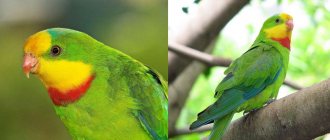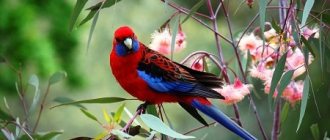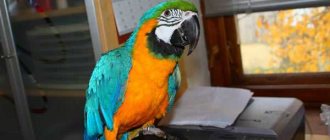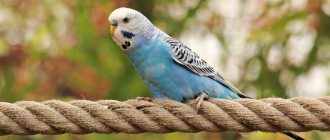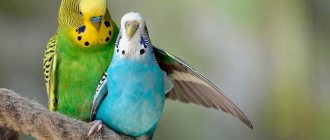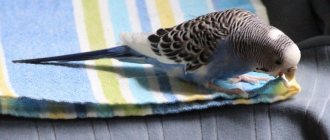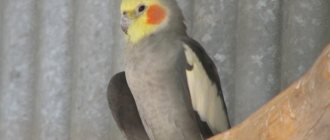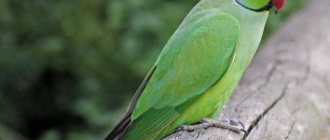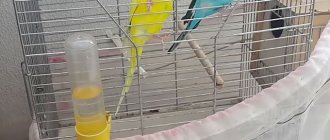Green is the dominant color in many species of parrots around the world, including those that are often kept as pets. If you spot a green parrot, you can identify the bird by size, feather pattern, and many other criteria. Some green parrots have extra bright colors mixed into their plumage, while others have more subtle markings. These birds are intelligent and full of personality and require a dedicated caregiver. If you're considering adopting a bird, here are eight popular green parrots to choose from.
Budgie
Perhaps the most famous pet green parrot is the budgerigar (or parakeet). Although not solid green, common budgies are a mixture of yellowish-green flecks with black spots and striped patterns. Budgerigars are very intelligent and social, but they are still quite easy to care for. They can be housed in a relatively small space compared to larger parrots, but they need a lot of mental and physical exercise.
External links [edit]
- World Parrot Trust Encyclopedia of Parrots: Species Profile
- Green parrot photo gallery on VIREO
- Neotropical Birds, Cornell Lab of Ornithology: Species Profile
- eBird from the Cornell Lab of Ornithology: Species Profile
| Taxon identifiers |
|
Eclectus
One of the most colorful green parrots is the Eclectus. Eclectus is sexually dimorphic, meaning you can tell the sex of a bird by its plumage. If you spot a large, bright green parrot with a distinct orange beak, chances are you've seen an eclectus. Females are mostly bright red. These birds are very sociable and affectionate, but can easily become stressed if they feel neglected.
Links[edit]
- ^ a b
BirdLife International (2012).
" Forpus passerinus
".
IUCN Red List of Threatened Species
.
2012
. Retrieved November 26, 2013.CS1 maint: ref=harv (link) URL of old form - ^ a b c d e f g h i j k l m n o p q r
“Green Parrot (Forpus passerinus) |
Encyclopedia of Parrots". www.parrots.org
. Retrieved March 16, 2021. - "Green Parrot". Retrieved March 17, 2021.
- "Green Parrot - eBird". ebird.org
. Retrieved March 17, 2021. - Forshaw, Joseph (2006). Parrots of the world
. Princeton, NJ: Princeton University Press. paragraph 123. ISBN 978-0-691-09251-5. - Stotz, D. F.; Fitzpatrick, J. W.; Parker III, T.A.; Moskowitz, D. K. (1996). Neotropical Birds: Ecology and Conservation
. Chicago: University of Chicago Press. ISBN 978-0226776309. - Berg, Carl S; Delgado, Soraya; Okawa, Ray; Basinger, Stephen; Bradbury, Jack (2011). "Contact calls are used for individual female recognition in free-ranging green parrots, Forpus passerinus
."
Animal behavior
.
81
(1):241–248. DOI: 10.1016/j.anbehav.2010.10.012. - Beissinger, S. R. (2008). "Long-term studies of the green parakeet (Forpus passerinus) in Venezuela: hatching asynchrony, social system, and population structure." Ornithology Neotropical
.
Neotropical Ornithological Society. 19
: 73–83. S2CID 44861681. - Beissinger, S. R.; Waltman Jr. (October 1991). "Extraordinary clutch size and hatching asynchrony in a Neotropical parrot" (PDF). Auk
.
American Ornithological Society. 108
(4):863–871. Retrieved May 23, 2014. - Pacheco, Massachusetts; Basinger, S.R.; Bosquet, K. (July 1, 2010). “Why do they grow slowly in a dangerous place? Postnatal growth, thermoregulation and energetics of green-crested parrot (Forpus passerinus) chicks.” Auk
.
American Ornithological Society. 127
(3):558–570. DOI: 10.1525/auk.2009.09190. - Budden, A. E.; Basinger, S. R. (January 14, 2009). "Resource allocation depends on parental sex and brood size in the asynchronously hatching green-rumped parrot (Forpus passerinus)" (PDF). Behavioral ecology and sociobiology
.
63
(5):637–647. DOI: 10.1007/s00265-008-0698-x. - Siegel, RB; Weathers, W. W.; Basinger, S. R. (May 1999). "Hatching asynchrony reduces the duration, but not the magnitude, of peak production in green parrot (Forpus passerinus) breeding." Behavioral ecology and sociobiology
.
45
(6):444–450. DOI: 10.1007/s002650050583. - Curlee, A.P.; Basinger, S. R. (December 1, 1995). "Experimental analysis of mass changes in female green parrots (Forpus passerinus): the role of male cooperation." Behavioral Ecology
.
6
(2): 192–198. DOI: 10.1093/beheco/6.2.192. - Waltman, Jr.; Basinger, S. R. (March 1992). "Reproductive behavior of the green-rumped parrot". Wilson's Bulletin
.
Wilson Ornithological Society. 104
(1):65–84. JSTOR 4163117. - "Wild Bird Conservation Act". US Fish and Wildlife Service. Retrieved June 13, 2014.
Indian ringed parrot
While selective breeding has resulted in a variety of colors, Indian ringneck parrots are most often pastel green in color. These green parrots are not the best choice for inexperienced bird owners. These parrots often go through a "bluff" phase during adolescence, which is characterized by hormonal aggression. They are also quite intelligent birds that need a lot of mental and physical stimulation to keep them happy.
Reproduction
First of all, before the female lays eggs for reproduction, she and her companion need to worry in advance about finding a place optimally suitable for the nest. For the most part, they choose tree hollows located at the very top. With this, birds take care of safety from uninvited visitors, as well as predators.
We think you will be surprised by the fact that sometimes the choice of birds falls on hollows at a height exceeding thirty meters. It is directly there that the females improve the nesting house. It is amazing that this process can last about a month, during which the female will not leave her new home and fly far away.
Often the bird can be seen in an entertaining position, with half of its body peeking out of the nest and its bright scarlet head rotating in different directions.
When the period to lay eggs comes, the female separates in the depths of the house, entrusting the responsibility for her own food to the male of her pair. The male does not refuse these obligations, but uninterruptedly supplies food to both his beloved and the emerging heirs.
The female lays a small number of eggs in a clutch, consisting of literally a couple of eggs, which she incubates for almost a month, as a result of which very tiny and helpless chicks hatch.
Depending on the habitat, nesting can occur both in August and in another period, from October to January.
The female will worry about the life of her cubs until the stage when they are unable to fly out of the nesting house. Their father at this time, as mentioned earlier, will regularly deliver food for his family.
An unusual fact that will cause you no less surprise is that eclectus, in comparison with other species of birds, has one fascinating distinctive feature. Males are worried not only about their beloved, but also help other females.
As for the offspring, the male provides them with food for about three months of life after birth. It is believed that this amount of time is necessary for the chicks so that they become stronger and can say goodbye to their home.
Green-cheeked red-tailed parrot
These parrots are small, fluffy birds that have mostly green plumage with grey, red and blue. They tend to bond closely with their caregivers and love to play and socialize. But they tend to collect feathers if they are bored or neglected. So make sure you can spend a few hours a day interacting with this bird before you adopt him.
Taxonomy[edit]
This species was previously classified in the genus Aratinga
as
A. holochlora
and was divided into various subspecies (
A. h. Holochlora, A. h. Brevipes, A. h. Brewsteri, A. h. Strenua
and
A. h. Rubritorquis.
).
[3] [2] It was later divided into three species: green conures ( A. holochlora
), Pacific conures (
A. strenua
) and socorro conures (
A. brevipes
).
[4] Today it is recognized as the only species with a critically endangered subspecies ( Psittacara holochlorus brevipes
), endemic to Socorro in the Revillagigedo Islands, Mexico. [5]
Amazon parrot
Papagaios at Chapada imperial
Amazon parrots are among the largest and most recognizable green parrots. There are several species, including the blue-eyed Amazon, yellowish Amazon and double-headed Amazon. Each type is predominantly green with different markings to make it stand out. They are intelligent, social creatures that require a lot of attention from their owner, as well as plenty of space to play with them.
Similar articles
Signs of a Healthy Budgerigar
Budgerigars are very hardy birds. They usually do not show signs of illness until later stages of the disease. For this reason, it is important to know that Read more
Fun facts about parrots
Parrots are fun and playful companions, but there is much more to these little birds than meets the eye. The following are below Read more
Types of parrots with green plumage
Among the many breeds of green parrots, varieties such as eclectus, amazons, soldier's macaws, monks, necklaces and wavy ones deserve special attention.
Eclectus
A fairly large green parrot, 35-40 cm long and weighing 360-450 g. It has a short square tail, gray paws, long, beautifully rounded wings and a large beak with a smooth glossy upper beak.
The male is covered with green plumage, tinged with yellow on the head. The bottom of the tail is yellow with a greenish tint, the sides are red, the flight feathers are blue with green edges. The upper part of the beak is colored red or orange, the lower part is black. The female is covered in red or red-brown plumage with a blue belly, breast and nape.
There may be violet-blue eye rings around her eyes. The beak is black, the iris is light yellow.
Interesting! Because of such noticeable differences in plumage color, ornithologists have long been convinced that red and green eclectus parrots belong to different species. But thanks to observations of the behavior of birds during the mating season, they came to the conclusion that it was a female and a male.
Eclectus inhabit Australia, New Guinea and adjacent islands. They are found in coconut groves and dense tropical forests and nest in tree hollows. During the day, the birds spend time alone or in pairs, and at night they gather in small flocks. They feed on plant foods and often raid corn fields and oil palm plantations.
Amazon
This is a typical American species of green parrot , whose distribution range is Central and South America. It lives in warm, humid tropical forests and savannas.
This breed of green parrots is large in size. Birds grow up to 25-45 cm in length and weigh between 300-700 g. Amazons have a short rounded tail, small wings and a powerful beak, which can easily crack nuts. This species of bird is easily recognizable by its variegated bright green plumage with colored spots on the wings, tail, back of the head, head and neck.
Interesting! According to various classifications, Amazons are divided into 26-32 species, 18 of which are listed in the Red Book, 1 is under the close supervision of ornithologists and 2 are considered extinct.
Small flocks of Amazons spend most of their time in the trees. American green parrots make a lot of noise and only become silent after dark. After waking up, the Amazons take roll call and during the day they accompany all their actions with loud screams.
These green parrots are considered one of the best sound mimics. They skillfully copy various melodies, voices of people and animals.
Ruffled parrot
These green parrots live in the African tropics and almost throughout South Asia. They live in forests and spend time in the crowns and hollows of trees. Birds are grouped in large flocks, the number of which sometimes reaches several hundred birds.
Necklace parrots are medium in size and grow up to 30-60 cm with a weight of no more than 150 g. They have short, poorly developed legs, a large strong red beak, pointed wings and a narrow stepped tail. The birds are covered with grass-green feathers with a yellowish tint. And on the neck of males there is a bright, dark-colored “necklace”.
On a note. Green parakeets with red beaks have an alternative name - they are called ringed or Cramer's parakeets.
In their homeland, birds are not considered exotic and often live close to people. Flocks of green parrots raid agricultural crops and orchards, causing significant damage to farmers. They often leave forests altogether and move to large cities.
Soldier's Macaw
These green parrots are found in Nicaragua, Panama and Costa Rica. They live in humid tropical valleys and dry areas at altitudes up to 700 m above sea level. Birds live in pairs or family groups.
The soldier's macaw is a large green parrot, it grows up to 80-85 cm in length and weighs 900-1000 g. The bird has gray paws, a black beak and a light yellow iris. The parrot's body is dominated by green plumage with a slight yellowish tint. The undertail, underwings and back are yellow-bronze, the head is light green with small black splashes in the facial area.
The cere and forehead are red, the back of the head is greenish-blue. The bird's flight feathers, tail feathers and coverts are blue. The tail is brown with blue tips.
The Soldier's Macaw is a sociable and good-natured green parrot that makes an excellent family pet. He easily makes contact with people, but sometimes he is capricious. This green parrot subtly senses its owner's mood and is able to copy other people's emotions.
Parrot monk
This green parrot received the name “monk” due to the unusual colors associated with the cloak of clergy.
These green parrots inhabit the northern regions of Argentina, southern Brazil, Greece, Spain, the Bahamas, Italy, Bolivia, Uruguay and Paraguay. They live in palm groves, dense forests and mountainous slopes at altitudes up to 3000 m above sea level. Birds, also called Quakers, gather in flocks of 200-500 individuals and sometimes move closer to people.
On a note. Green Quaker parrots destroy cereal crops and raid orchards. Therefore, they are considered pests and in some countries they are even shot.
Monk parakeets grow up to 30 cm and weigh 100-150 g. They have long wings, a narrow stepped tail and a thick, curved beak of a nut-brown color. The back, nape and wings of the bird are covered with yellowish-green plumage. The chest, neck, forehead and crown are ash-gray, the belly is gray with a greenish tint. The tail is blue-green, the flight feathers are blue with bright blue tips.
Quakers are cheerful, sociable and easy to tame parrots. They get along well with people and other pets as they see them as part of their pack. Green monk parrots are able to memorize up to 200 words and understand their meaning. Quakers can hum various melodies and can imitate laughter, sneezing, coughing and other sounds.
Wavy
Australia is considered the homeland of these small parrots. Their natural habitat covers the eastern and southwestern coasts of the continent and the territory of nearby islands. They gather in noisy flocks and inhabit meadows, savannas, eucalyptus thickets and forests.
Interesting! During flight, budgies can reach speeds of up to 120 km/h. Thanks to this, the birds manage to escape from predators.
Budgerigars grow up to 17-20 cm and weigh 40-45 g. They have a long stepped tail, which makes them appear larger than they actually are. The natural color of budgies is green. The throat and front part are colored yellow, and there are blue spots on the sides of the head. Black waves run along the back of the head and upper parts of the body. These small parrots have a strong curved beak, with which they carry various objects, move along branches and defend themselves from enemy attacks.
Green parrots are beautiful birds with camouflage coloring that helps them survive in their natural environment. Thanks to it, birds easily blend into the surrounding vegetation and remain unnoticed.
